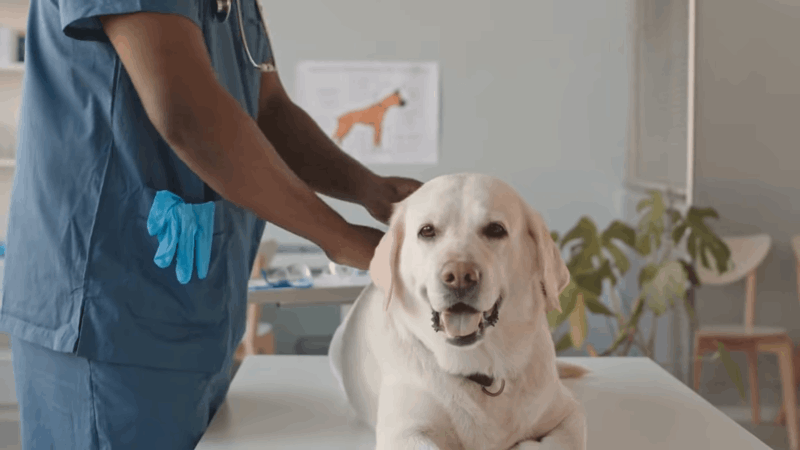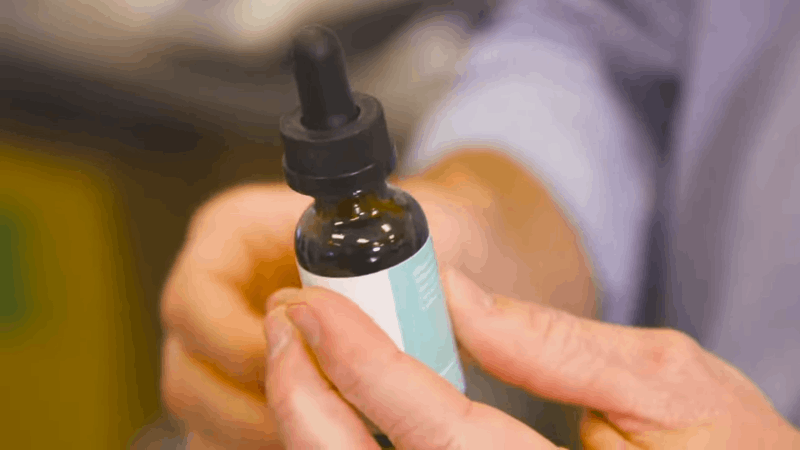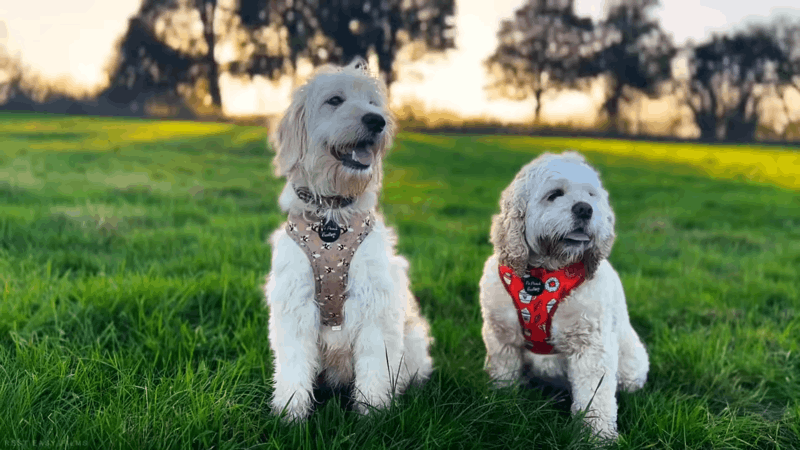No products in the cart.
CBD oil for dogs after spay surgery is becoming a favored choice for pet owners seeking natural pain relief and comfort for their recovering pets. Spaying, a common surgical procedure that involves the removal of a female dog’s reproductive organs, can lead to discomfort and anxiety, which CBD oil aims to alleviate.
We will explore the medical advantages of CBD oil in this blog, covering everything from stress relief to pain control, and we offer you professional guidance on how to safely include this all-natural supplement in your dog’s post-surgery treatment.
What is Spay in Dogs and What You Need to Know

Spaying in dogs is a surgical treatment that removes a female dog’s reproductive organs, specifically the ovaries and, in most cases, her uterus. This procedure is medically known as an ovariohysterectomy. The primary purpose of spaying is to prevent unwanted pregnancies, thereby helping to control the pet population.
It also eliminates the possibility of the female dog going into heat, which can attract male dogs and lead to behavioral changes. Furthermore, there are health advantages to spaying, including a lower chance of infections and some types of cancer in dogs.
Benefits of Spaying Your Dog
Here are some of the key advantages that spaying your dog can offer:
Health Benefits
- Prevention of uterine infections (Pyometra): Pyometra is a serious and potentially life-threatening infection of the uterus. Spaying eliminates the risk entirely by removing the uterus and ovaries.
- Reduced risk of mammary (Breast) cancer: Spaying before the first heat cycle significantly reduces the risk of mammary cancer. Dogs spayed after their first heat but before the second also have a reduced risk, though not as significant.
- Elimination of ovarian and uterine cancer: The uterus and ovaries are removed to totally eliminate the chance of developing these malignancies.
- Prevention of pseudopregnancy: Some unspayed dogs can experience false pregnancies, leading to behavioral changes and physical symptoms like lactation. Spaying prevents this condition.
- Control of hormonal imbalances: Spaying helps in managing and stabilizing hormonal fluctuations that can lead to various health issues.
Behavioral Benefits
- Reduction of heat cycle behavior: Dogs in heat can display undesirable behaviors such as frequent urination, howling, or nervousness. Spaying eliminates these behaviors as the dog will no longer go into heat.
- Reduced aggression: Some female dogs can become aggressive due to hormonal changes during heat cycles. Spaying can help in reducing this aggression.
- Decrease in roaming: Dogs in heat often roam in search of a mate, which can lead to accidents or getting lost. Spayed dogs are less likely to exhibit this behavior.
Population Control Benefits
- Reduction in unwanted litters: Spaying helps in controlling the pet population by preventing unplanned litters, thereby reducing the number of homeless dogs and the burden on animal shelters.
- Contributing to the overall reduction of stray animals: By reducing the number of stray animals, spaying contributes to fewer animals suffering from hunger, disease, and abuse.
Economic Benefits
- Lower long-term veterinary costs: Preventive health measures such as spaying can save money on treatments for reproductive-related health issues and certain types of cancer.
- Reduced costs for pet owners and communities: Managing unplanned litters and stray animals can be costly. Spaying helps reduce these costs for both individual pet owners and municipalities.
Community and Social Benefits
- Enhancement of community health: The spread of diseases, which leads to better public health like rabies and parvovirus, can be reduced by fewer stray animals.
- Improvement of shelter conditions: Animal shelters often operate beyond capacity. Spaying improves the quality of care for animals in need by lowering the quantity of animals coming into shelters.
Ethical and Responsible Pet Ownership
- Promoting responsible pet ownership: Spaying your pet shows that you are a conscientious pet owner that cares about both the welfare of the community and your pet.
- Reduction of euthanasia rates: By preventing unwanted litters, spaying helps reduce the number of animals that are euthanized due to overpopulation.
Overall, spaying is a responsible decision that can enhance your dog’s quality of life and benefit the larger community.
What is the Best Age to Spay a Dog?
The breed, size, and overall health of the dog are some of the variables that affect the ideal age to spay or a dog.
| Breed Size | Recommended Age to Spay | Considerations |
| Small Breeds | Before the first heat cycle (5-6 months) | Reduces the risk of mammary cancer and prevents pregnancies. |
| Medium Breeds | Before the first heat cycle (5-6 months) | Same as small breeds; early spaying is highly beneficial. |
| Large Breeds | Around 9 to 15 months | Balances bone and joint health with cancer prevention. |
| Giant Breeds | 12 to 18 months | Allows full physical development to reduce orthopedic issues. |
Depending on the specific characteristics and health profile of your dog, veterinarians can provide ideal guidance so consulting with them is essential. This personalized advice ensures that the timing of the spay procedure supports the best possible outcome for your dog’s overall health and well-being.
Care for Dog after Spay

After spaying, it’s important to provide your dog with a quiet place to recover. Limit her physical activity to prevent strain on the stitches and ensure the incision heals properly. Check the incision site daily for signs of infection such as redness, swelling, or discharge.
Pain management is crucial, so follow your veterinarian’s instructions for administering any prescribed medications. Also, ensure your dog wears a cone or protective garment to prevent licking the wound, which can lead to complications.
Dog not Eating after Spay
It’s common for dogs to have a decreased appetite immediately after surgery due to the effects of anesthesia and the stress of the procedure. However, her appetite should return within 24 to 48 hours. Contact your veterinarian if your dog still isn’t eating after a couple of days, or if she shows other symptoms like lethargy or vomiting. It could indicate pain or infection that needs further treatment.
Do Female Dogs Calm Down after Being Spayed?
Spaying often leads to a calmer demeanor in dogs, mainly because it stops the hormonal changes that come with heat cycles. This can mean less hyperactivity and aggression. However, a dog’s basic personality and energy level will generally remain consistent, influenced also by genetics and environment.
How Long Does It Take for a Dog to Recover from Being Spayed ?
The recovery period for a dog after being spayed typically lasts about 10 to 14 days. During this time, it’s crucial to follow post-operative care instructions to ensure a smooth recovery. Most dogs will start to behave more like themselves a few days after surgery as they adjust. Complete healing and the ability to resume all normal activities may take a couple of weeks.
How Far Can I Walk My Dog after Spaying?
In the first week after spaying, it’s best to avoid any walks beyond short trips to relieve herself. After the first week, if the recovery is progressing well, you can gradually increase the length of the walks. Avoid strenuous activity and jumping for at least two weeks after the surgery. When you are not sure about the appropriate level of activity, speak with your veterinarian and always watch for any signs of discomfort or complications in your dog.
Natural Pain Relief for Dogs after Spaying

After spaying, managing your dog’s pain naturally can involve techniques such as gentle massage around the non-sensitive areas to promote circulation and reduce tension. Cold compresses can be applied to the body (not directly on the incision) to help reduce inflammation. Additionally, ensuring your dog has a comfortable, soft place to rest can also aid in reducing discomfort during recovery.
CBD Oil for Dogs after Spay Surgery
CBD oil can be a beneficial supplement for dogs recovering from spay surgery, offering pain relief, reducing inflammation, and calming anxiety. Choosing a high-quality, pet-safe CBD oil and starting with a low dosage are so important, adjusting as necessary based on your veterinarian’s guidance.
CBD includes anti-inflammatory and analgesic properties which can help dogs feel comfortable during the recovery process, easing discomfort and promoting a more relaxed state.
Additionally, CBD oil can stimulate appetite and support the immune system, promoting overall healing. To ensure that CBD is a safe and effective part of your dog’s post-surgery care, please monitor her response to CBD closely and consult with a ve regularly.
Creating a Calming Environment for Spay Healing Process in Dog
Creating a calming environment for your dog during the spay healing process involves several thoughtful steps to ensure her comfort and promote a smooth recovery:
- Quiet space: Set up a quiet, low-traffic area for your dog to rest without disturbance from household noise or other pets.
- Comfortable bedding: Provide soft, supportive bedding to help your dog lie down comfortably without putting pressure on the incision site.
- Controlled temperature: Keep the room at a comfortable temperature, avoiding extremes that could affect your dog’s comfort.
- Gentle handling: When interacting with your dog, be gentle and avoid jarring movements that could stress the surgical site.
- Soothing sounds: Consider playing soft music or white noise to help soothe your dog and keep her calm during the recovery period.
You may create an environment that aids in your dog’s physical and mental healing by paying attention to these little things.
Conclusion
CBD oil for dogs after spay surgery can be a soothing natural remedy to aid your pet’s recovery. By easing pain and reducing anxiety, this supplement helps make the healing process more comfortable for your dog. Ensure you choose a vet-approved, high-quality CBD oil and consult with your veterinarian on the right dosage. With CBD oil, you can help your dog recover more peacefully, getting them back on their paws and into playtime sooner.
Hello, I am Hazel Bennett, an experienced copywriter specializing in the fascinating topic of CBD for dogs. With a passion for pet wellness and extensive knowledge of CBD’s potential benefits, I am here to provide you with informative and engaging content.



